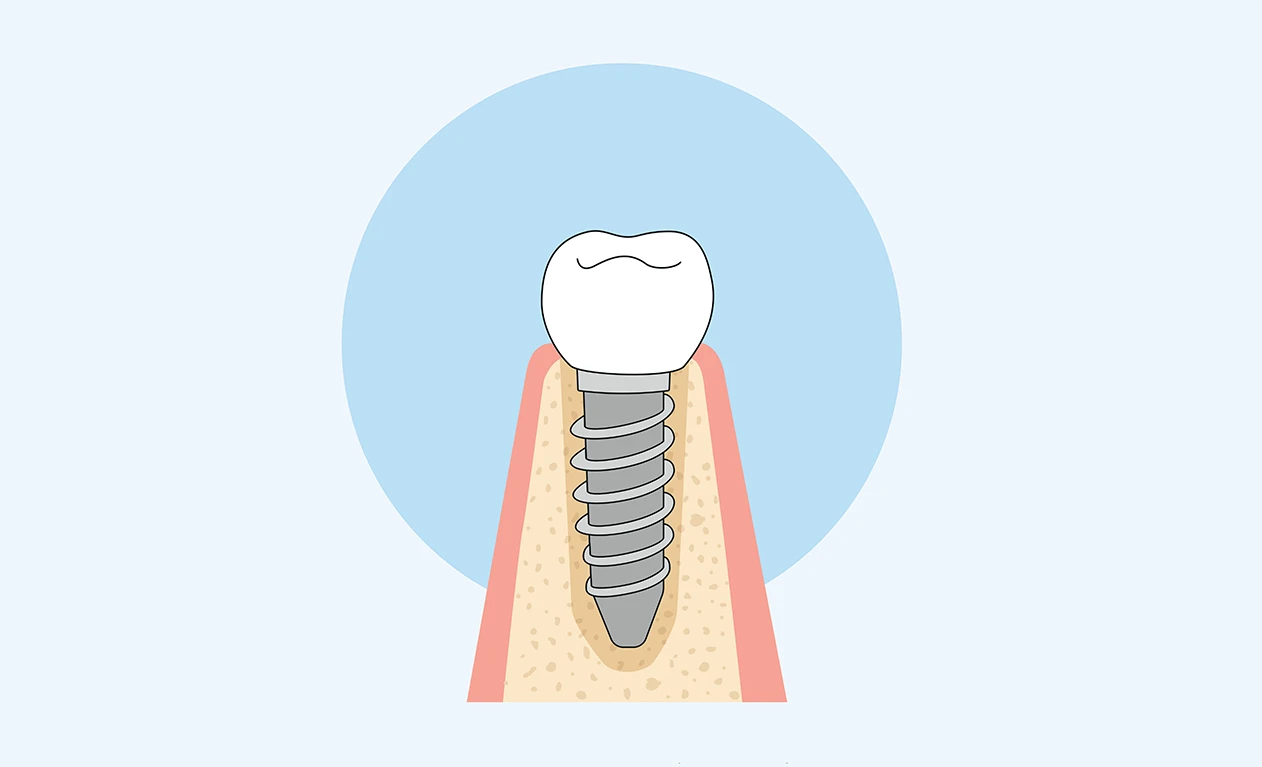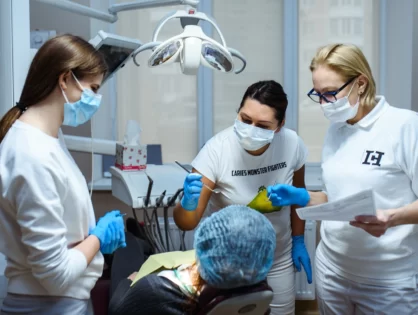Implantation has significantly expanded the possibilities of dentistry. Since 1965, when Professor Per-Ingvar Brånemark proposed to use in dentistry an implant and abutment as an “artificial root” for a “new” tooth. Modern dentistry has improved methods of prosthetics, materials, and techniques. Although the dental implant procedure is 57 years old, there are still many questions in society regarding this method of restoring tooth function.
Our dentists will give answers to the most popular of them.
Why it’s done?
Dental implantation is a surgical procedure of application of a metal device (implant) into the jawbone that provides support for teeth crowns, bridges, or dentures. Implants are used both for a single-tooth loss and for prosthetics of two or more teeth without injuring adjacent teeth. Thanks to implantation, you can restore the aesthetics of a smile and the functionality of the dentition in the lower and upper jaws.
What is a dental implant?
A dental implant is a titanium structure in the form of a screw, plate, or a plateau, which is used in dentistry as a replacement for the natural tooth root during prosthetics of the dental unit. In dentistry, there are many options for implants and their classification:
- depending on length: standard and short (up to 5 mm)
- depending on the method of fastening — screw or in the form of a plateau, basalt or zygomatic
A dental implant consists of the body integrated into the jawbone and an abutment that connects the implant screw and crown.
How to prepare for dental implants?
Before the procedure, the patient undergoes computer tomography (CT of the jaws) to assess the thickness of the bone tissue on the jaw, the angle of the jaw, the size, and depth of the maxillary sinuses and other anatomical features. Then the condition of the oral cavity is checked. If necessary, sanitation of the oral cavity is carried out — removal of dental plaque and stone, treatment or removal of destroyed teeth. If there are chronic inflammations (carious teeth, infection of the root canals, periodontal tissue disease), mandatory treatment is carried out. This is necessary to create normal conditions for implant integration. After clinical examinations, additional studies and specialist consultations may be required to ensure there are no contraindications for implantation.
Would it be possible to insert implants if there are no teeth at all?
Yes, it is. Moreover, depending on the condition of the bone tissue and the patient’s treatment budget limits, it is possible to install implants using the all-on-4 or all-on-6 method — this is when you can completely restore the chewing function of the jaw by installing only 4 or, respectively, 6 implants.
When would it be possible to install an implant after a tooth extraction?
The implant can be installed immediately after tooth extraction. If the tooth was removed, and the implant was not installed immediately, then the optimal installation “window” is 3–5 months after removal. This time will be enough for the tooth cavity to heal and the bone not to atrophy significantly.
Would it be possible to place multiple implants at once?
Yes, sure, if there is an indication for such an installation and the specific clinical situation allows.
When is a dental implant not allowed?
Absolute contraindications to implantation are:
- malignant formations HIV
- active phase of tuberculosis
- some diseases of the circulatory system
- bone tissues disease
In such cases, after additional examinations and consultations of related specialists, the doctor, and the patient decide on the planning of implantation. Relative contraindications include pregnancy and lactation. These physiological states are related and fundamentally affect metabolism, including calcium. Therefore, the structure can take a very long time to take root and not integrate with the bone tissue of the jaw.
Atrophy of bone tissue — what is it and what to do about it?
This is the process of resorption of the maxillary ridge. The issue is accompanied by a decrease in the height and density of bone tissue.
Bone atrophy is provoked by:
- chronic inflammatory processes
- loss of one or more teeth
- anatomical abnormalities of the jaw
- congenital anomalies
- acquired injuries.
To install the implant, 5-10 mm of bone tissue is required. If it is not enough, then dentists can perform procedures to increase bone volume: sinus lifting, bone autotransplantation.
Is implant rejection possible?
Yes, rejection of dental implants is observed in up to 3% of patients. As a result of the inflammatory reaction, the implant may not integrate with the jaw bone. In this case, the implant will not withstand the load during biting or chewing and must be removed and reinstalled (if the clinical situation allows). Both medical errors and violations of the rules of postoperative care by the patient can cause the rejection of the implant. For example, smoking, too early load on the structure, violation of oral hygiene.
How long do dental implants last?
The average service life of the structure is 10–15 years. But in practice, with proper oral hygiene, implants function for 20 years or more.
What is “laser implantation”?
This is one of the methods of cutting soft tissues during prosthetics. Instead of a metal scalpel, the mucous membrane is cut with a laser tool. Actually, this is the difference from “common” implantation. Laser implantation is, in fact, a marketing tool. After all, the success of the implantation procedure does not depend on the method of cutting the tissue, but on the skill of the dental surgeon, the quality of the materials, and the patient’s following properly postoperative recommendations.
Would it be possible to do an MRI with dental implants?
Mostly, dental implants are made of titanium alloy. This metal belongs to the group of paramagnets, which, by the way, includes platinum and aluminum. Titanium structures are almost unaffected by the magnetic field: they do not heat up, do not shift relative to their initial position, and do not distort images. So, the MRI procedure is completely safe for such patients. The main thing is to warn the diagnostician about the presence of dental implants.
What is the all-on-4 technique?
This is one of the methods of dental prosthetics. Modern technologies make it possible to install “new teeth” for a patient using this technology within 24 hours. 4 (or 6) implants are installed on the jaw: two from the front, the others from the side. A prosthesis is put on such a structure. The single design evenly distributes the load on the entire jaw, insures against uneven loading of implants. And a moderate additional immediate load gives a positive effect for the further integration of the metal structure into the bone tissue.
The benefits of all-on-4 are:
- the possibility of installation in case of bone tissue deficiency
- the possibility of prosthetics for patients with osteoporosis, diabetes
- the possibility of obtaining a relatively quick prosthetic result.
What is the difference between All-on-4 and All-on-6 techniques?
“All-on-4” and “All-on-6” have similar techniques. The difference is the number of implants. With the All-on-6 method, there are two more of them.
This method is used in:
- a large radius of the arch of the lower jaw
- thickened bones in the front part of the jaw
- implants on the upper jaw. Anatomically, the bone on the upper jaw is more porous. Therefore, for a better fixation of the prosthesis, a more even distribution of the load on the jaw, it is recommended to install two additional implants, that is, to use the All-on-6 technology
Which implants are better to choose
Only a dentist can choose the implant system, the supplier, the type of abutment, as well as the method of prosthetics. The decision is made on the basis of preliminary diagnosis (CT-jaw), clinical situation, as well as the wishes and financial possibilities of the patient. When selecting the type of implant, the condition of the bone (width, depth, structure (porous or density), the size of the maxillary sinuses, other anatomical features of the upper and lower jaw) is considered. In prosthetics issues, you should trust the opinion of an experienced doctor.
Such specialists will help safely and effectively restore the aesthetics of a smile at any age!
Schedule an appointment for a consultation with a dentist!




